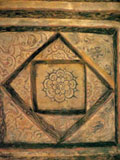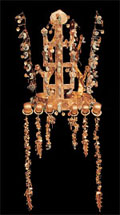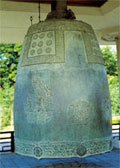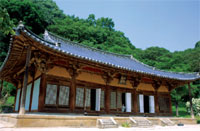Fine Arts
Though people started living on the Korean Peninsula in the Paleolithic Age, existing remains indicate that the origin of fine arts dates back to the Neolithic Age (c. 6,000-1,000 B.C.). Rock carvings on a riverside cliff named Ban-gudae in Ulsan on the southeast coast feature vivid descriptions of animals and are noteworthy art from the prehistoric age. The aesthetic sense of this era can also be found in the comb and eggplant pattern on pottery for daily use.
In the Bronze Age (c. 1,000-300 B.C.), a variety of bronze goods including mirrors, bells and pendants were produced, most of which are presumed to be indicative of authority or designed for religious purposes and were intended to inspire awe.
During the Three Kingdoms era, Goguryeo (37 B.C.- A.D. 668), Baekje (18 B.C.- A.D. 660) and Silla (57 B.C.- A.D. 935) each developed different fine arts influenced by their own unique geographical, political and societal circumstances.
Mural paintings from Goguryeo tombs, mostly found around Jiban and Pyongyang, illustrate the art of this kingdom. The murals on the four walls and ceilings of the burial chambers feature figures depicted in brilliant colors and energetic and dynamic movement, illustrating ideas about life on earth and in the afterlife.

Ssangyeongcheong (Tombs of Double Columns), a celing painting of Goguryeo Kingdom (37 B.C. - A.D. 668)
In the meantime, the official recognition of Buddhism during the Three Kingdoms led to the creation of Buddhist statues. One prime example is the statue of Maitreya (the Buddha of the Future) sitting in meditation with his finger touching his cheek.

Gold crown of Silla Kingdom (57 B.C. - A.D. 935)
Seokguram Grotto, the quintessence of the fine arts of Unified Silla, is an unrivalled masterpiece in respect to the majestic figures, their realistic expressions and unique features. In addition, Silla artisans also excelled in producing temple bells. Bronze bells like the Divine Bell of King Seongdeok manufactured in the late 8th century are well known for their elegant designs, sonorous sound and impressive size.
The artistry of Goryeo (918-1392) can be best appreciated by its celadon ware. The jade green color, elegant designs and great variety of Goryeo celadon are profoundly beautiful and quite different from Chinese ceramics. Up until the first half of the 12th century, Goryeo celadon was noted for its pure color, while in the second half of the century, the technique of incising designs into clay and then filling the recesses with white or black slip came to stand out as a main characteristic.

The Divine Bell of King Seongdeok (late 8th century) is the largest of its kind in Korea
Buncheong, stoneware made of gray clay and decorated with white slip coating, was one kind of ceramic produced during the Joseon Dynasty. It was coated with a celadon-type gray-blue glaze. Also typical of this period was white porcelain and blue-and-white porcelain. Used by common people in their daily lives, Buncheong ware is decorated with unconstrained patterns. White porcelain, exhibiting a perfect harmony between curves and subtle color tones, is an example of the acme of beauty. Beginning in the mid-15th century, blue-and-white porcelain began to exhibit a brilliant aesthetic sense thanks to the picturesque patterns painted in blue cobalt pigment on the white porcelain surface.
During the Joseon Dynasty (1392-1910), traditional construction, which sought harmony with the natural landscape, flourished in great variety and sophistication. Sungnyemun (also known as Namdaemun) in downtown Seoul is an especially valued example of the architectural style of the early Joseon Dynasty. It and numerous temple and palace buildings are being rebuilt or restored using traditional methods.

Muryangsujeon, the oldest wooden structure in Korea
Since the 1960s, in Korea's pursuit of industrialization and urbanization, the Government pushed ahead with development plans and a number of beautiful old buildings were demolished and replaced by unsightly structures.
However, in recent years, there have been active discussions in this regard while the time-honored concept of harmonizing buildings with nature is being revived.
|
|